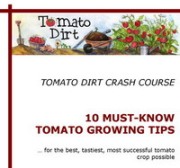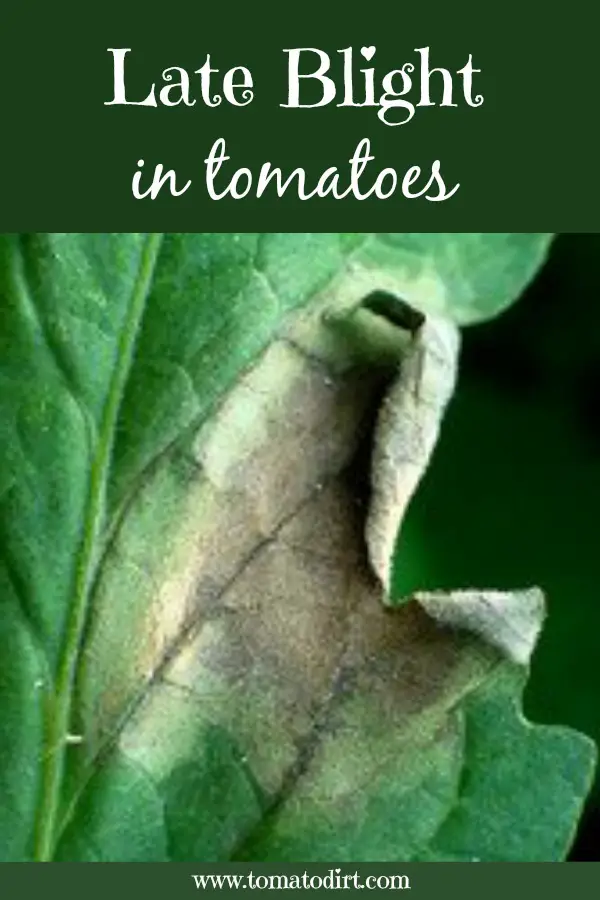Tomato Blight: How to Identify and Treat Late Blight in Tomatoes
Since 2010, Tomato Dirt has garnered 4.8+ million views, making it the web’s leading online source for growing tomatoes in the home garden. Award-winning writer and Tomato Dirt owner Kathy Widenhouse has helped thousands of home gardeners grow healthier tomatoes. Be one of them when you get Tomato Dirt’s Growing Guide here.
Updated 6.16.24
Tomato blight, in its different forms, is a disease that attacks a plant’s leaves, stems, and even fruit.
Late blight (one form of tomato blight) is caused by a fungus, Phytophthora infestans, which also affects potatoes. The fungus was responsible for the Irish potato famine of 1845.
What does late blight look like?
The fungus over-winters in infected potato tubers and perennial weeds (such as nightshade.) As the tubers and perennial seeds germinate during a new growing season, the fungus spreads to surrounding plants.
Late blight affects both leaves and fruit.
Leaves develop blue-gray spots which turn brown.
Leaves eventually drop.
Fruit develops irregular brown, greasy spots which can affect the entire tomato.
Spots on both leaves and fruit may develop a white, cottony ring of mold.
Late blight can overtake an entire plant quickly (within a week) if untreated.
When does late blight affect plants?
- It’s most prevalent in mid- to late-season
- It often strikes in cool, wet weather
How do you control and treat late blight?
- The best control measure for tomato blight is prevention (see below).
- Remove and destroy infected leaves (be sure to wash your hands afterwards).
- Once blight is present and progresses, it becomes more resistant to biofungicide and fungicide. Treat it as soon as possible and on a schedule.
- Organic fungicides. Treat organically with copper spray, which you can purchase online, at the hardware store, or home improvement center. Follow label directions. You can apply until the leaves are dripping, once a week and after each rain. Or you can treat it with a host of other natural fungicides for tomatoes.
- Chemical fungicides. Some gardeners prefer chemical fungicides, the best of which for tomatoes is chlorothalonil (sold as Fungonil, Daconil, or under other brand names. Check labels. You may also choose Mancozeb or Maneb, although these have longer wait times before you can harvest tomatoes safely than does chlorothalonil.
Other diseases (such as early blight, Septoria leaf spot, and gray leaf spot) can also be controlled by these biofungicides and fungicides, so application is multi-purpose.
How do you prevent late blight?
- Rotate crops. The tomato blight (late blight) fungus can remain in the soil for several years. Be especially careful not to plant tomatoes in an area where potatoes were cultivated the year before.
- Plant disease-resistant hybrids to strengthen your plant’s chances of being blight-free.
- Plant tomatoes in a raised bed to improve drainage and prevent diseases from spreading.
- Give tomato plants extra space (more than 24 inches) to let air to move among leaves and keep them dry.
- Water the soil – not the plants – to prevent splashing. Avoid overhead watering.
- Mulch with black plastic or landscape fabric to prevent fungus from spreading up onto leaves.
- Stake tomato plants for better circulation.
- Remove and destroy affected plants at the end of the season.
Tomato problems from diseases
Different kinds of tomato blight and how to tell them apart ...
How to identify and treat early blight ...
How to identify and treat Septoria leaf spot ...
Fungicide for Tomatoes: A Primer ...
Tomato anthracnose: how to identify and treat it ...
How to identify and treat gray leaf spot ...
How to identify and treat fusarium wilt ...
How to identify and treat verticillium wilt ...
How to identify and treat bacterial wilt ...
How to understand tomato disease resistance codes ...
How to choose and apply fungicide to tomato plants ...
How to choose a garden sprayer that is best for you ...
Get more info on our Tomato Diseases Pinterest board...
Tomato pests
Tomato hornworm: how to identify and control it ...
Tomato worms-cutworms: keep them away with stem collars ...
Stink bugs: how to identify and control them on tomato plants...
Tomato problems from growing conditions
Blossom Drop: why fruit doesn't set and what to do about it ...
Why a tomato cracks and what to do about it ...
Tomato sunscald: why too much sun can be hazardous to tomatoes...
Blossom end rot: how to identify, treat, and prevent it ...
How to identify and treat phosphorus deficiency in tomatoes ....
Are bumps on tomato stems harmful to plants?
How to identify tomato problems and prevent them ...
Return from Tomato Blight: How to Identify and Treat Late Blight to Tomato Dirt home
As an Amazon Associate and Rakuten Advertising affiliate I earn from qualifying purchases.
SHARE THIS PAGE:
FREE! 10 Must-Know Tomato Growing Tips: 20-page guide
Get yours here:





New! Comments
Have your say about what you just read! Leave a comment in the box below.